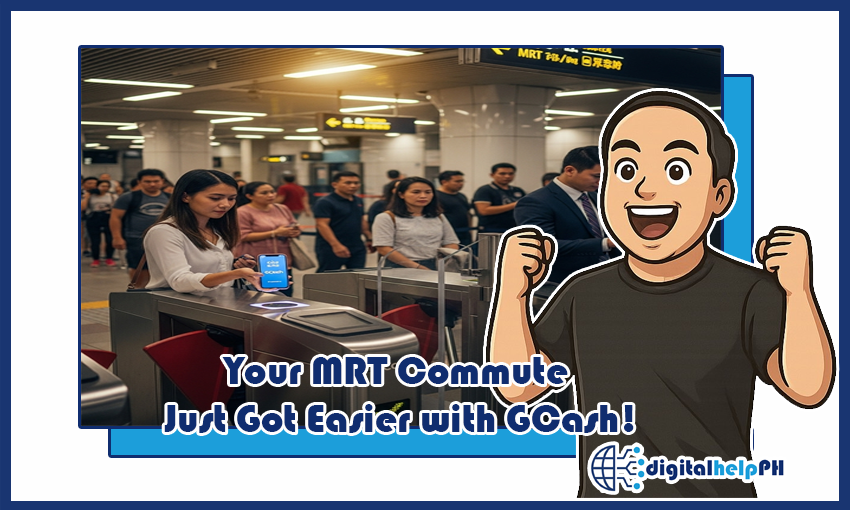Last Updated on September 25, 2025
The daily grind for Metro Manila commuters just received a significant upgrade! Starting July 25, 2025, riding the MRT-3 is officially stepping into the future with the full implementation of cashless payment systems, prominently featuring your favorite e-wallet: GCash. No more fumbling for exact change or waiting in long lines for a Beep card top-up – your smartphone is now your ticket to a faster, more convenient journey.
This move by the Department of Transportation (DOTr) aligns perfectly with the nation’s push towards digitalization, making public transport more efficient and accessible for everyone. But what exactly does this mean for your commute, and how can you make the most of this new system? Let’s dive in.
Contents
Say Goodbye to the Hassle: How GCash Transforms Your MRT Experience
For years, the Beep card has been the go-to for MRT and LRT rides. While convenient, it often required separate loading stations and occasional queues. Now, with GCash integration, the process is streamlined to an unprecedented degree.
Imagine this: you walk up to the MRT-3 turnstile, pull out your phone, scan a QR code or tap your device, and you’re in! It’s that simple. This is a game-changer for regular commuters and even occasional riders, significantly reducing transaction times and making the entire experience smoother. During this initial phase, all 13 MRT-3 stations are equipped with at least one cashless turnstile to facilitate this new payment option.
Your Step-by-Step Guide to Paying MRT with GCash
Ready to embrace the cashless future? Here’s how you can pay for your MRT ride using GCash:
- Ensure Your GCash Account is Funded: Before heading to the station, make sure your GCash wallet has sufficient balance. You can easily top up via online banking, convenience stores, or remittance centers.
- Locate the Designated GCash Entry Points: Look for clearly marked turnstiles or payment areas at MRT-3 stations. These will typically display QR codes or NFC tap points for e-wallet payments.
- Scan or Tap:
- For QR Code Payment: Open your GCash app, select “Pay QR,” and scan the QR code displayed at the turnstile. Confirm the fare amount on your screen.
- For Tap-to-Pay (if available/enabled): Ensure your phone’s NFC is on, open your GCash app (or just unlock your phone if set up for express payment), and tap it on the designated reader.
- Proceed Through the Turnstile: Once the payment is successful, the turnstile will open, and you can proceed to the platform. It’s truly that fast!
Important Note on GCash Fare Calculation:
It’s crucial to understand how the fare works with GCash. Upon tapping in, a standard fare (currently ₱28, equivalent to the end-to-end journey) will be initially withheld from your GCash account. The system will then automatically calculate the actual fare based on your distance travelled and refund any excess amount upon your tap-out at your destination station. Always remember to tap out!
Beyond GCash: What Other E-Wallets and Payment Options Are Available?
While GCash is taking center stage due to its widespread adoption, the DOTr’s initiative for MRT cashless payment extends to other digital payment methods. Commuters can also expect:
- Other Major E-wallets: Keep an eye out for announcements regarding integration with other popular e-wallets like PayMaya (now Maya). As the system matures, more options are likely to be included.
- Credit/Debit Cards: Select turnstiles are also equipped to accept credit and debit card payments, offering another layer of convenience for those who prefer card transactions. Currently, Mastercard and Visa debit/credit/prepaid cards from various banks (including but not limited to BPI, BDO, RCBC, Landbank) are also accepted at the cashless turnstiles.
- The Beep Card: For now, the trusty Beep card remains an option. This ensures a smooth transition for commuters still adjusting to the new digital payment landscape.
What’s Next? Cashless on LRT-1 and LRT-2!
The good news doesn’t stop with MRT-3! Transportation Secretary Vince Dizon has confirmed that these cashless payment systems, including GCash and other e-wallets, will be rolled out to LRT-1 and LRT-2 very soon. This promises a more integrated and digitalized public transport network across Metro Manila, making your future commutes even more seamless.
The Benefits Are Clear: Why This Matters to You
- Faster Commutes: No more queues for reloading or ticket purchases.
- Enhanced Convenience: Pay with what you already have in your pocket – your phone!
- Reduced Contact: A more hygienic way to pay, especially relevant in today’s world.
- Financial Inclusion: Encourages the use of digital financial services for everyday transactions.
- Modernization of Public Transport: Paves the way for even more technological advancements in the Philippine transport sector.
Pro-Tips for a Smooth Cashless Ride:
- Check Your Balance: Always ensure you have sufficient funds in your GCash wallet before heading to the station.
- Update Your App: Keep your GCash app updated to ensure you have the latest features and bug fixes.
- NFC On: If you plan to use tap-to-pay, make sure your phone’s NFC is enabled.
- Stable Connection: While QR scanning often works offline after initial login, a stable internet connection can help with real-time transaction updates.
A Step Towards a Smarter Philippines
The GCash MRT launch isn’t just about paying for a train ride; it’s a significant leap towards a smarter, more efficient urban environment. As more public services embrace digital payments, the Philippines is steadily progressing towards becoming a truly cashless society.
Are you excited about this new development? Have you tried paying for your MRT ride with GCash yet? Share your experience in the comments below!

